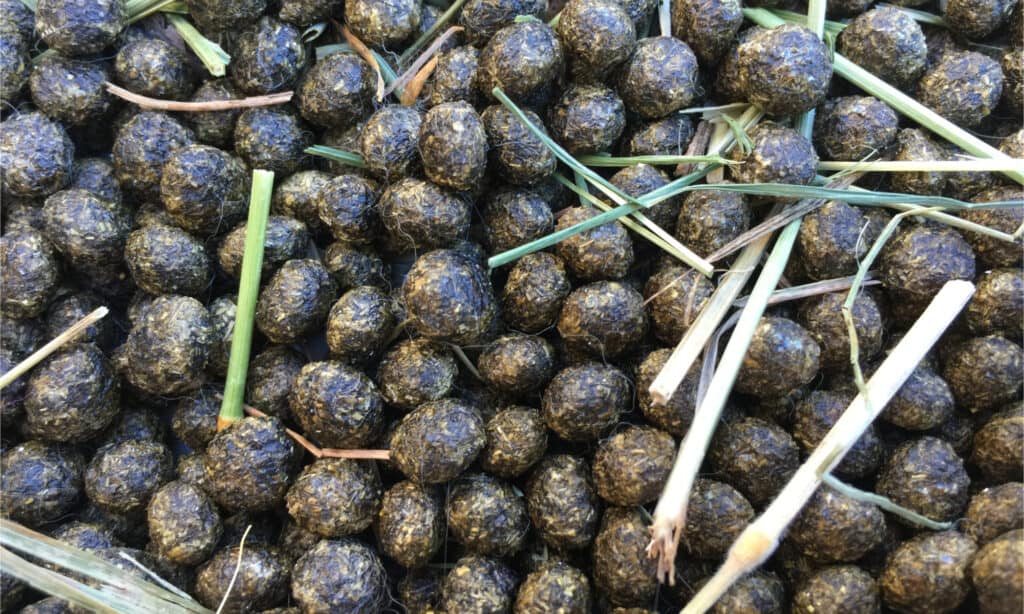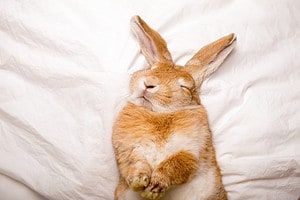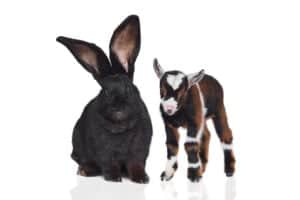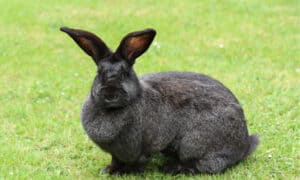Do you have rabbits as pets, or do you intend on getting one? If so, you must be fully knowledgeable about rabbit poop because that is one crucial way to determine if your pet rabbit is as healthy as it should be. Unlike dogs or cats, which are easy to detect when something is bothering them with their health, rabbits often pretend to be healthy even when they are not. Fortunately, there is one sign that they can’t truly conceal – their feces. To know which rabbit dropping is healthy and which is not, you must first know what normal rabbit droppings look like.
Rabbits defecate a lot. One of the first things a new rabbit owner will discover is that. Fortunately, rabbit dung is not at all disgusting, and their feces resemble dry, odorless cocoa puffs. Particularly if your rabbit is litter box trained, they are simple to clean. In all honesty, your rabbit poop is perhaps the least disgusting poop you’ll ever have to deal with. This article will show you what rabbit droppings look like, what kind of food rabbits eat, and many other facts you need to know about rabbit poop.
What Do Rabbit Droppings Look Like?

Rabbit feces are typically pellet-shaped.
©KanphotoSS/Shutterstock.com
These typical rabbit feces, also known as fecal pellets, ought to resemble cocoa puffs. Depending on the rabbit, the precise size and color may differ slightly.
The size of the rabbit and their excrement do not necessarily correlate. Fecal pellets that are larger than those of a 10-pound rabbit have been known to occasionally be produced by very small rabbits. Therefore, getting to know your own rabbit’s poop is critical, so you are clear about what is normal for your rabbit.
Here’s everything you need to know about the appearance of normal rabbit droppings:
Color
A rabbit’s feces should be medium green, dark green, dark brown, or nearly black, although they can sometimes be more tan or wheat-colored. You shouldn’t be concerned if the color seems a little light as long as your rabbits’ poop is consistently colored. If your rabbit excrement is particularly dark, it may indicate that their food contains too much protein. But occasionally, it simply boils down to how the rabbits digest their food. Orchard hay is a protein-rich variety of hay ideal for young rabbits’ nutritional requirements. However, some fully grown ones can find it to be overly rich.
Shape and Size
Spherical and slightly smaller than a chickpea, rabbit feces are typically pellet-shaped. Sometimes, you may notice some shape distortion, especially during the shedding season when the pellets are packed with additional fur.
Healthy rabbit dung typically measures between 7 mm (0.27 inch) and 12 mm (0.47 inch) in diameter or roughly the size of a green pea to a chickpea. Each excrement should have the same size, and concern should be expressed if there is a significant difference in the size of the poop.
Texture and Consistency
Rabbit excrement should be hard and not squishy at all. But they shouldn’t be too hard as well. A pellet should fit easily between your thumb and forefinger with just a little pressure. They should break open if you apply pressure on them with your fingers or if you step on one by accident. However, the interior ought to resemble digested, dusty hay, similar to sawdust. It shouldn’t be soft or exhibit any other common animal excrement characteristics.
Amount and Smell
You might be shocked by this, but normally, a rabbit makes 200 to 300 pellets daily. That’s a lot of poo! The smell of rabbit excrement is not overpowering to human noses. If your rabbit’s litter box has a noticeable odor, it almost certainly comes from their pee rather than their feces.
You must be aware of what is typical and what to watch out for to monitor your rabbits’ health through their feces. But remember that consistency is what you should be looking for in your rabbit’s excrement. It’s alright if some of your rabbit’s excrement is the size of a sweet pea while others are the size of a chickpea. You don’t need to be concerned as long as your rabbit’s excrement is consistently about the same size and color.
Do Rabbits Eat Their Poop?

Rabbits must consume poop to pass food through their stomach a second time.
©Poly Liss/Shutterstock.com
To keep themselves healthy, rabbits must consume their own waste. Yes, you did read that correctly. Because not all nutrients are absorbed the first time food passes through their gastrointestinal tract, rabbits must consume poop to pass food through their stomach a second time. This makes it possible for the body to absorb and utilize the nutrients in the food.
However, this cellulose-rich, fibrous meal isn’t the simplest to digest, and by the time their food has passed through their intestines, many of the nutrients the bunnies require are still there. This process is called coprophagy, which has a similar purpose to cows chewing their cud.
With a unique digesting process, rabbits and hares can overcome this issue. In other words, they consume their own waste to digest it twice. Interestingly, bunnies produce two distinct types of excrement: the soft, black ones called cecotropes and the tiny, spherical, normal droppings.
Do Rabbits Vomit?
The simple answer is no. As a result, it is crucial for a rabbit’s digestive tract to remain in good working condition because they must re-ingest their cecotropes to obtain the nutrients they require. Since they cannot puke, bunnies are helpless if anything gets caught in their esophagus or intestines.
What Do Rabbits Eat?

Rabbits are purely herbivores. However, contrary to what cartoons may have you believe, rabbits don’t merely enjoy munching on lettuce and carrots. In actuality, rabbits consume a variety of grasses, vegetables, and plant material as part of a balanced diet. Rabbits have evolved to consume a variety of greens because their bodies need a lot of fiber to aid in the digestion of all that raw plant materials. Yet, there are some foods that rabbits genuinely enjoy and will consume in large quantities. This includes weeds, insects, bark, hay, grasses, leaves, pellets, fruits, vegetables, and more.
Pet rabbits typically consume the same foods as wild rabbits do. A pet rabbit’s diet should typically consist of 80 to 90 percent grasses and hay. That said, it can be challenging to locate all of the wild grasses that wild rabbits consume for food. Pet rabbits will thus consume a slightly different diet than wild rabbits. In addition, a lot of rabbit owners provide their pets with vegetables and leafy greens.
Carrots are a good source of carbs, so while rabbits can eat them, they shouldn’t do so frequently. Broccoli, clover, kale, spinach, dandelion greens, and flowers are more veggies pet rabbits can eat but shouldn’t consume too frequently. You may, in rare instances, give your pet rabbit fruits.
What Are Cecotrope Droppings From Rabbits?
The other common sort of rabbit feces is called cecotropes. These are little clusters of soft pellets that are rich in nutrients. They are created in the rabbit’s cecum, where naturally occurring bacteria and fungi work to convert the indigestible components of the animal’s diet into this vital nutrient. That implies that for rabbits to obtain all the nutrients they require from their diet, they must consume their cecotropes.
You won’t typically find many cecotropes lying around because rabbits consume them straight out of their anus. However, on rare occasions, you can discover some that your bunny missed. It could be time to examine your rabbit’s nutrition if you notice a lot of cecotropes. When rabbits consume an excessive amount of sugar, they overproduce cecotropes.
Cecotropes are only a few millimeters in diameter by themselves, but you will frequently observe them in groups, clusters, or berry-like structures. Even though the clusters are often one to two inches long, it is not uncommon to discover just a few cecotropes grouped together. These clusters are typically dark brown, and due to the thin mucus coating covering the cecotropes, they will also have a slight shine. These are also stickier than typical rabbit excrement, therefore it’s possible that they also contain some nearby hay or hair.
The cecotropes will smell if the delicate membrane covering them is torn, and they’ll emit a strong odor. Therefore, if you suddenly detect a strong feces odor, seek a nearby crushed cecotrope and give it to your rabbit to consume.
Do Rabbit Droppings String Together?
Yes, rabbit dung will occasionally be connected by fur to resemble a string of pearls. You may probably occasionally notice this in your rabbit’s poop because it is a rather typical occurrence. Since rabbits will ingest more hair when shedding, this is especially typical during a significant molting season or with long-haired breeds of rabbits.
These chains of excrement should still contain uniformly sized and colored poop. The areas where the hair strand protrudes to link the following poop in the line may be a little distorted, but generally, they should still be well-formed balls with a firm texture.
What Rabbit Poo Can Tell You About Your Pet’s Health
Those dark pellets can provide clues as to your bunny’s state of health. Hence paying attention is recommended since you will need to take the furball to the vet in the event of any deviation from the norm which includes:
Mucus-covered Rabbit Poop
If there’s mucus in your rabbit’s droppings, it may be a sign that the bunny is suffering from a parasitic infection. That said it may also occur if your furry friend has just been treated with antibiotics.
Diarrhea
This rare occurrence is most certainly cause for alarm and your pet will have to be taken to the vet at once (along with some of its droppings). Diarrhea in rabbits is generally caused by potent toxins or microbes. It may also occur in little bunnies which might have been given their first taste of solid food before they were fully ready for it.
Cecal Dysbiosis
The burning temptation to feed your little friend an abundance of carrots, breads, cookies, shop-bought treats, and even hay with fancy additives, is best avoided.
Foods high in simple sugars, yet low in fiber can cause an imbalance in your pet’s gut microflora. The result? Foul smelling, undefined stools as a result of excessive fermentation and the proliferation of Escherichia coli and Clostridium – a condition which can prove fatal for your pet.
The photo featured at the top of this post is © mkzdillon/Shutterstock.com
Thank you for reading! Have some feedback for us? Contact the AZ Animals editorial team.






